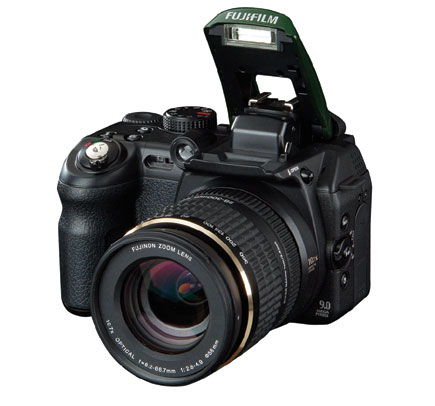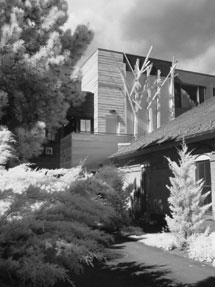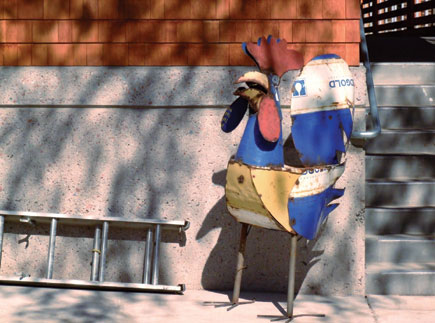Fujifilm’s IS-1; The FinePix S3 Pro UVIR Gets A Little Brother
The fascination with digital infrared photography continues to grow and Fuji follows up the introduction of the FinePix S3 Pro UVIR D-SLR with an electronic viewfinder (EVF) fixed-lens camera called the IS-1. (See our review of the UVIR on www.shutterbug.com by typing FinePix S3 Pro UVIR into the Search box.) Don't think Fuji is just concerned about the aesthetic applications of digital IR photography. Nope, like the FinePix S3 Pro UVIR, the Fujifilm IS-1 will be used by law enforcement to solve crimes by capturing evidence not easily seen by the human eye. The camera can be used in both the visible and infrared light spectrums and has a continuous live preview feature, which is a big advantage for focusing and composing when using the dark filters that infrared photography requires. The IS-1 also has a 2" articulated LCD that simplifies previewing, capturing, and reviewing images, IR or otherwise.
 |
The IS-1 uses a 9-megapixel Fujifilm Super CCD sensor with an ISO sensitivity range of 80-1600, enabling IS-1 shooters to capture images using visible and infrared light (approximately 400--900 nm.) To isolate specific wavelengths you'll need to use different lens filtration to achieve a specific effect. The camera's Picture Stabilization feature is selectable on the camera's Mode dial and increases ISO sensitivity along with high shutter speed settings (not optical stabilization) to reduce any blur caused by camera shake. Fuji bundles its Hyper Utility Software HS-V2 that enables IS-1 photographers to get the most from the camera's raw file format, which is a good thing because the .RAF files that the IS-1 produces cannot be read by even the very latest version of Adobe Camera Raw. That may change in the future but in the meantime, Fuji provides both Mac OS and Windows XP versions of the software.
 |
|
|
In The Field
In operation, the IS-1 bears some resemblance to the S3 Pro UVIR, sometimes
to its detriment. The controls, menus, and buttons can be confusing and counterintuitive,
although I am not sure die-hard Fuji users will notice. The rest of us should
keep the Owners Manual handy for even the simplest settings such as changing
to/from JPEG to Raw Capture mode. Oh wait, you can't. Fuji only provides
the 1S-1 Owners Manual as a PDF file on a CD, so bring along a laptop computer
or have all 163 pages printed at Kinko's.
(CCD-RAW, as Fuji prefers to call it, is set in the Setup Menu, not in the Quality
Menu as you might suspect.)
 |
|
|
The camera has two memory card slots: one for CompactFlash, the other for the mostly useless xD-Picture Cards. Speaking of "mostly useless," while the lens has a 35mm equivalent of 28-300mm, there is also a 2x digital zoom option. If you care about quality, you'll just forget this fact. Unlike lots of digital cameras, the IS-1 lets you use a real cable release and the best traditional release that I've found is Nikon's AR-3, that costs about $15.
 |
|
|
I'm no fan of EVF cameras but the IS-1 could change my mind for two big reasons: the resolution of the tiny screen is extremely fine (235,000 pixels) and doesn't exhibit the coarse rendition that plagues most other EVF cameras, including those from Fuji. Oh yeah, and it shows 100 percent of the image, which eliminates compositional surprises. What makes it really unique is that the Fujifilm IS-1 is the first IR-capable camera I have tried that lets you use the dense filters required for infrared capture and still be able to see the effect in the viewfinder before you snap the shutter.
 |
|
|
The camera's lens has a 58mm filter size but none of the IR filters
in my collection are that size so I just held them in front of the lens. If
you do this be careful because in addition to the chance of getting your pinky
in the shot you can also physically push the zoom lens in changing its focal
length and ending up with a much different focal length than you thought you
were going to get. Fuji provided me with a Peca IR filter that performed spectacularly
well with the IS-1. Peca's website (www.pecascientific.com)
has an entire section dedicated to the S3 Pro UVIR so they seem on top of the
forensic applications of IR photography. During my testing I also tried IR filters
from B+W, Cokin, and Singh-Ray, all of which produced slightly different but
excellent results.

































